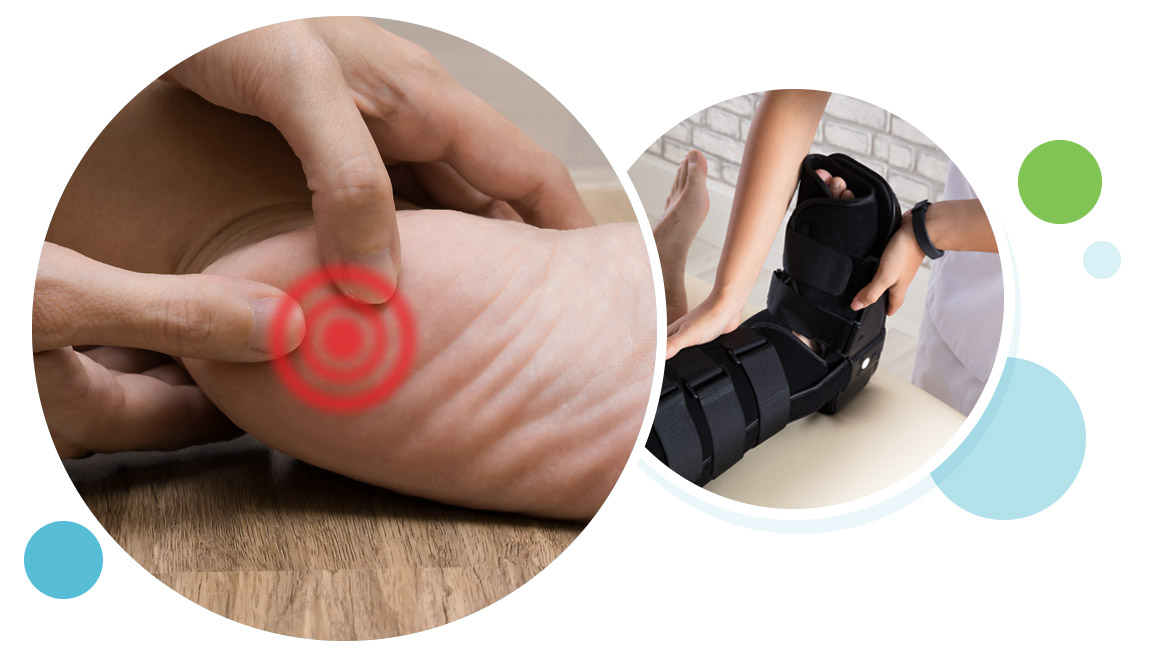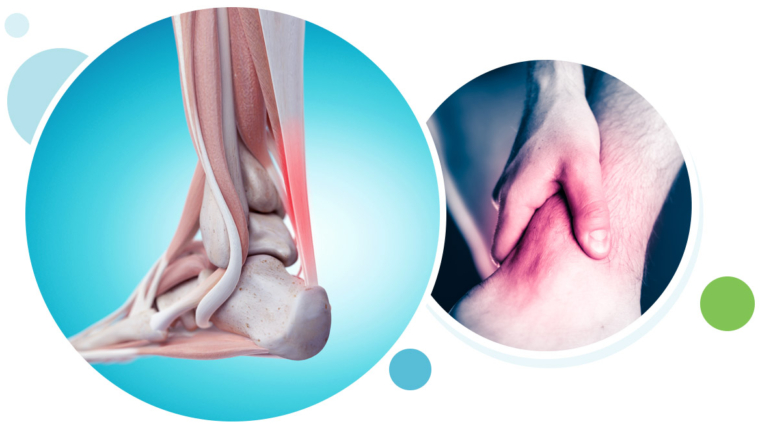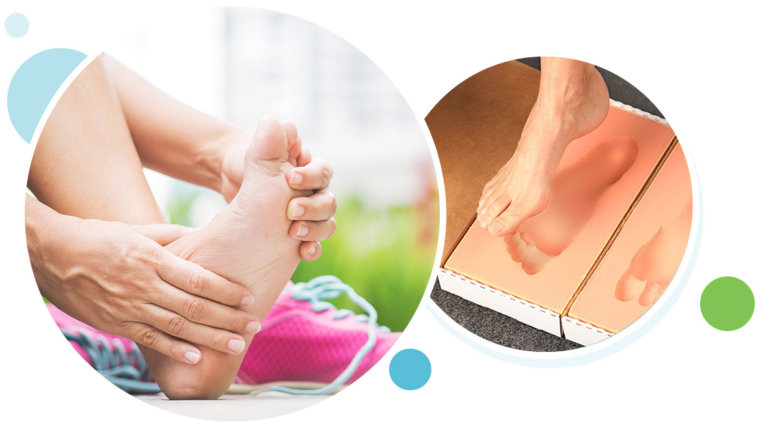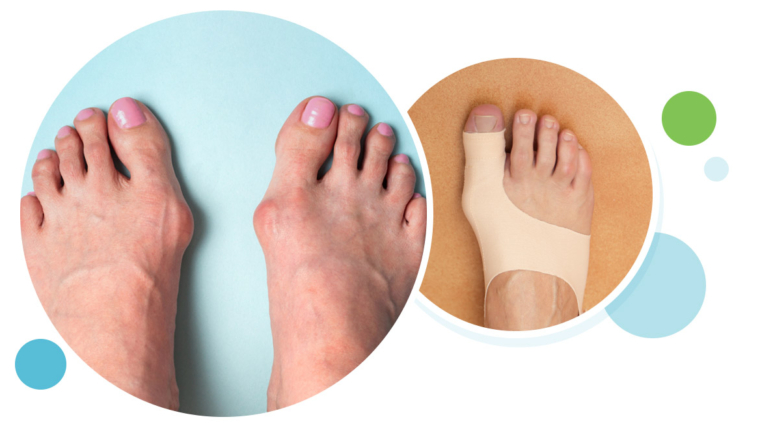What is Plantar Fasciitis?
Plantar fasciitis is the term commonly used to refer to heel and arch pain traced to an inflammation on the bottom of the foot. More specifically, plantar fasciitis is an inflammation of the connective tissue, called plantar fascia, that stretches from the base of the toes, across the arch of the foot, to the point at which it inserts into the heel bone. Overpronation is the most common cause of plantar fasciitis. As the foot rolls inward excessively when walking, it flattens the foot, lengthens the arch, and puts added tension on the plantar fascia. Over time, this causes inflammation.
The symptoms of plantar fasciitis are:
- Pain on the bottom of the heel.
- Pain that is usually worse upon arising.
- Pain that increases over a period of months.
People with plantar fasciitis often describe the pain as worse when they get up in the morning or after they’ve been sitting for long periods of time. After a few minutes of walking the pain decreases, because walking distributes that inflammation that has pooled. For some people the pain subsides but returns after spending long periods of time on their feet. Typically, the longer the pain stays typically the worse it has infiltrated the fascia.
Also known as heel spur syndrome, the condition is often successfully treated with conservative measures, such as the use of anti-inflammatory medications, stretching exercises, orthotic devices, and physical therapy. Note: Please consult your physician before taking any medications. In persistent cases, more advanced intervention may be indicated such as Platelet-Rich Plasma (PRP) or amniotic injections or Shockwave therapy. Rarely is surgery indicated.
Non-surgical Treatment
A variety of treatment options, often used in combination, are available to treat plantar fasciitis. These include:
- Orthotic devices. Over the counter or custom shoe inserts may be prescribed to help maintain the arch and limit excessive motion that can cause pull on the fascia or compression of the nerve.
- Shoes. Supportive shoes may be recommended or a shoe like a cowboy boot because temporarily using a slight heel is helpful.
- Physical therapy. Exercises and other physical therapy modalities may be prescribed to reduce symptoms and get the nerve moving again.
- Elevation of the heel. Elevating the heel prevents further injury and encourages healing by taking the stretch off the fascia and Achilles tendon.
- Ice. Apply an ice pack to the affected area, placing a thin towel between the ice and the skin. Use ice for 20 minutes and then wait at least 40 minutes before icing again.
- Regenerative medicine. Shockwave therapy, MLS Laser Therapy, as well as PRP and Amniotic injections have all been shown to help patients with plantar fasciitis.
- Oral medications. Nonsteroidal anti-inflammatory drugs (NSAIDs), such as ibuprofen, help reduce the pain and inflammation. Injection therapy. Injections of a local anesthetic provide pain relief, and an injected corticosteroid may be useful in treating the inflammation.
- Immobilization. Patients with severe symptoms and nerve damage may be fitted with a cam walker or cast to reduce the amount of pressure on the foot. Restricting movement of the foot by wearing a cast is sometimes necessary to enable the nerve and surrounding tissue to heal.
Heel Fissures
Heel fissures is the term for cracking of the skin of the heels. This can be a painful condition that can cause bleeding. Open-backed sandals or shoes that allow more slippage around the heel while walking are often culprits that cause heel fissures. Skin conditions, such as eczema and psoriasis, can also lead to heel fissures. The skin thickens as a result of the friction. Wearing proper shoes and the use of deep skin moisturizers and lotions can reduce the dryness associated with the condition and allow the foot to heal.
Haglund’s Deformity
Haglund’s Deformity (also known as pump bump or retrocalcaneal bursitis) is a painful enlargement on the back of the heel bone that becomes irritated by shoes. It normally appears as a red, painful, and swollen area in the back of the heel bone. Women tend to develop the condition more than men because of irritation from rigid heel counters in shoes that rub up and down on the back of the heel bone.
Changing shoes, soaking feet, and anti-inflammatory medications often mitigate the symptoms of this problem. Note: Please consult your physician before taking any medications.
Tarsal Tunnel Syndrome
The tarsal tunnel is a narrow space that lies on the inside of the ankle next to the ankle bones. The tunnel is covered with a thick ligament (the flexor retinaculum) that protects and maintains the structures contained within the tunnel—arteries, veins, tendons, and nerves. One of these structures is the posterior tibial nerve, which is the focus of tarsal tunnel syndrome.
Tarsal tunnel syndrome is caused by anything that produces compression on the posterior tibial nerve, such as:
- A person with flat feet is at risk for developing tarsal tunnel syndrome, because the outward tilting of the heel that occurs with “fallen” arches can produce strain and compression on the nerve.
- An enlarged or abnormal structure that occupies space within the tunnel can compress the nerve. Some examples include a varicose vein, ganglion cyst, swollen tendon, and arthritic bone spur.
- An injury, such as an ankle sprain, may produce inflammation and swelling in or near the tunnel, resulting in compression of the nerve.
- Systemic diseases such as diabetes or arthritis can cause swelling, thus compressing the nerve.
Symptoms
Patients with tarsal tunnel syndrome experience one or more of the following symptoms:
- Tingling, burning, or a sensation similar to an electrical shock
- Numbness
- Pain, including shooting pain (the pain also often increases throughout the day)
- Aching
Non-surgical Treatment
A variety of treatment options, often used in combination, are available to treat tarsal tunnel syndrome. These include:
- Orthotic devices. Over the counter or custom shoe inserts may be prescribed to help maintain the arch and limit excessive motion that can cause compression of the nerve.
- Shoes. Supportive shoes may be recommended or a shoe like a cowboy boot because temporarily using a slight heel is helpful.
- Physical therapy. Exercises and other physical therapy modalities may be prescribed to reduce symptoms and get the nerve moving again.
- Elevation of the heel. Elevating the heel prevents further injury and encourages healing by taking the stretch off the nerve.
- Ice. Apply an ice pack to the affected area, placing a thin towel between the ice and the skin. Use ice for 20 minutes and then wait at least 40 minutes before icing again.
- Regenerative medicine. Shockwave therapy, MLS Laser Therapy, as well as PRP and Amniotic injections have all been shown to help patients with tarsal tunnel syndrome.
- Oral medications. Nonsteroidal anti-inflammatory drugs (NSAIDs), such as ibuprofen, help reduce the pain and inflammation. Injection therapy. Injections of a local anesthetic provide pain relief, and an injected corticosteroid may be useful in treating the inflammation.
- Immobilization. Patients with severe symptoms and nerve damage may be fitted with a cam walker or cast to reduce the amount of pressure on the foot.
When is Surgery Needed?
Sometimes surgery is the best option for treating tarsal tunnel syndrome. The foot and ankle surgeon will determine if surgery is necessary and will select the appropriate procedure or procedures based on the cause of the condition.




